兹维博迪金融学第二版课件Chapter08
兹维博迪 投资学 中文课件

标准普尔指数
标准普尔500指数
涵盖500家公司的指数
市值加权指数
投资者可以购买指数投资组合:
购买与各种指数相对应的共同基金
购买交易所交易基金 (ETFs)
2-25
其他指数
美国的指数 纽约证交所综合指数 纳斯达克综合指数 威尔希尔5000指数
国外的指数 日本日经指数 英国富时指数 德国综合指数 中国香港恒生指数 加拿大多伦多股市指数
2-20
图 2.6 抵押担保证券余额
2-21
权益证券
普通股:
代表所有权 剩余所有权 有限责任 永续性 固定收益 优先于普通服 税务处理
2-22
优先股:
美国存托凭证
股票市场指数
道琼斯工业平均指数
包括30家大型绩优公司 自1896年被计算出来 价格加权平均数
货币市场基金使得个人投资者可以购买各种货币市场 证券。
2-3
图2.1 货币市场的主要组成
2-4
货币市场证券
短期国库券: 美国政府发行的短期债务。
买方报价与买方报价 银行贴现法
大额存单: 银行定期存单 商业票据: 公司发行的短期无担保债务票据。
Байду номын сангаас
2-5
货币市场证券
银行承兑汇票: 银行客户向银行发出在未来某一日期支付 一笔款项的指令。 欧洲美元: 在美国以外的银行以美元计价的存款。 回购协议与逆回购: 由政府证券支持的短期借款。 联邦基金: 银行之间超短期借款。
2-6
货币市场工具的收益率
除了短期国库券,货币市场证券并不是没有违约风险。 银行大额存单一直以来持续支付高于短期国库券的风险溢 价,且该溢价在经济危机期间更大。 在2008年信用危机中, 在一些基金遭遇严重损失后,联邦 政府为货币市场基金提供了保险。
兹维博迪金融学第二版课件

兹维博迪金融学第二版
20
1.5 企业的组织形式
• 独资企业
• 一个人或家庭所有的企业 • 企业的资产和负债是所有者个人的资产和负债 • 无限责任 • 低管理成本
兹维博迪金融学第二版
21
• 合伙企业
• 至少有两个人分享所有权的企业。合伙协议通常 规定如何共同作出决策和利润(损失)如何共享 (共担)。
兹维博迪金融学第二版
8
• 人们利用金融系统来实施其金融决策。金融系统定义为用来订立 金融合约、交换资产与风险的一组市场和其他机构。
兹维博迪金融学第二版
9
• 金融理论包括:
• 一组概念,帮助一个人组织关于怎样跨时配置资 源的思考。
• 一组数量模型,帮助评估备选项、决策和实施决 策。
• 这些概念和模型适用于所有层次和规模的决策
预防损失 • 不动产管理
兹维博迪金融学第二版
41
税务管理
• 税务政策、程序的建立和管理 • 与税收征稽机构的关系 • 税务报告的准备 • 税务计划
兹维博迪金融学第二版
Hale Waihona Puke 42投资者关系• 建立和维护与投资群体的关系 • 建立和维护与公司股东的关系 • 向分析师咨询—公共财务信息
兹维博迪金融学第二版
43
离
• 1.7 管理的目标 • 1.8 市场性管束:收购 • 1.9 财务专家在公司中的
角色
兹维博迪金融学第二版
6
导言
• 我为退休储蓄。我应该用哪一种投资形式? 银行存单、共同基金还是直接买股票?
• 我想有一辆新车。我应该用存款购买还是租用? • 我正在考虑创业。它能带给我足够的回报吗? • 公司正寻求进军电信业。你应该给CFO提供怎样的建
兹维博迪金融学第二版课件
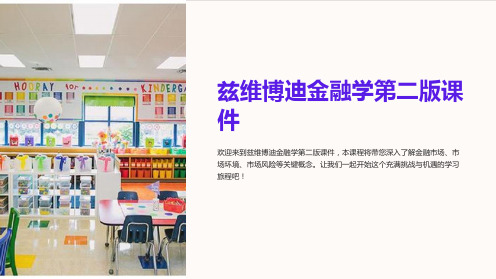
系统性风险
探索系统性风险的概念,包 括金融危机、政治不稳定和 经济周期波动等因素。
非系统性风险
分析非系统性风险对个别公 司或行业的影响,包括管理 风险、行业竞争和市场需求 波动等。
股票与债券
股票
深入了解股票市场的运作原理, 包括股票的购买、卖出和股息分 红等关键概念。
债券
多元化投资组合
研究债券市场的特点和运作方式, 包括债券利息、到期日和信用评 级等重要信息。
市场环境
1
宏观经济因素
了解宏观经济因素对金融市场的影响,包括经济增长、通货膨胀率和利率等。
2
政治与法律环境
探讨政治和法律环境对金融市场的重要性,包括政策变化、法规制度和国际贸易协议等。
3
社会氛围
分析社会氛围对金融市场的影响,包括人们对投资的态度、价值观和消费习惯等。
市场风险
市场波动
了解市场波动对投资者的风 险和机会,学会管理风险并 制定有效的投资策略。
探索如何建立一个多元化的投资 组合,有效分散风险并实现长期 收益。
经济增长与衰退
1
经济增长
了解经济增长的关键因素,包括生产率提高、投资增加和创新技术的引入等。
2
经济衰退
分析经济衰退的原因和影响,学会应对经济衰退的策略和措施。
3
经济周期
探讨经济周期的特征和不同阶段的投资机会,以及如何利用周期性变化来做出明智的投资决 策。
兹维博迪金融学第二版课 件
欢迎来到兹维博迪金融学第二版课件,本课程将带您深入了解金融市场、市 场环境、市场风险等关键概念。让我们一起开始这个充满挑战与机遇的学习 旅程吧!
课程介绍
在本节中,我们将探讨课程的内容、学习目标以及学习方法。通过本课程, 您将获得对金融学的深入理解,为未来的职业发展奠定坚实的基础。
《金融学教学课件》bodie2e_chapter08共52页
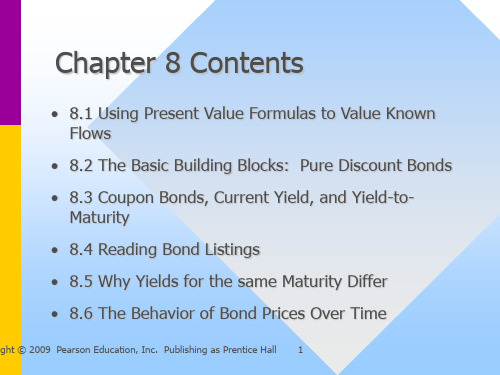
Bond Prices Rise as the Interest Rates Fall
• Write the PV of the fixed income security as the sum terms
8.1 Using Present Value Formulas to Value Known Flows
• You have been offered the opportunity to purchase a mortgage. It was originally part of a creative financing package where the original owner financed the buyer
NI
PV
PMT FV
60 1.5% ?
-400 0
15,752.11
ight © 2009 Pearson Education, Inc. Publishing as Prentice Hall 4
Change in Required Rate
• If your required rate of return increased to 1.6% / month
PV jn 1pm pm 2*t1 1i2.. .pm n1*t1 1in1pm n*t1 1in
ight © 2009 Pearson Education, Inc. Publishing as Prentice Hall 7
Bond Prices Rise as the Interest Rates Fall
金融学第二版讲义大纲及课后习题答案详解第八章
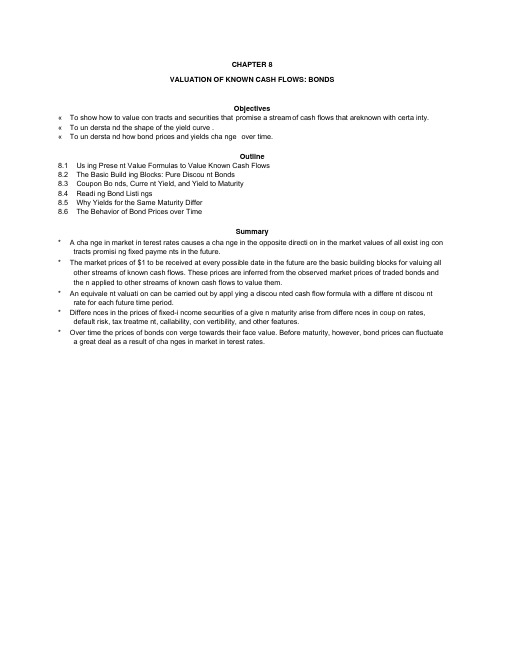
CHAPTER 8VALUATION OF KNOWN CASH FLOWS: BONDSObjectives«To show how to value con tracts and securities that promise a stream of cash flows that areknown with certa inty.«To un dersta nd the shape of the yield curve .«To un dersta nd how bond prices and yields cha nge over time.Outline8.1 Us ing Prese nt Value Formulas to Value Known Cash Flows8.2 The Basic Build ing Blocks: Pure Discou nt Bonds8.3 Coupon Bo nds, Curre nt Yield, and Yield to Maturity8.4 Readi ng Bond Listi ngs8.5 Why Yields for the Same Maturity Differ8.6 The Behavior of Bond Prices over TimeSummary* A cha nge in market in terest rates causes a cha nge in the opposite directi on in the market values of all exist ing con tracts promisi ng fixed payme nts in the future.* The market prices of $1 to be received at every possible date in the future are the basic building blocks for valuing all other streams of known cash flows. These prices are inferred from the observed market prices of traded bonds and the n applied to other streams of known cash flows to value them.* An equivale nt valuati on can be carried out by appl ying a discou nted cash flow formula with a differe nt discou nt rate for each future time period.* Differe nces in the prices of fixed-i ncome securities of a give n maturity arise from differe nces in coup on rates, default risk, tax treatme nt, callability, con vertibility, and other features.* Over time the prices of bonds con verge towards their face value. Before maturity, however, bond prices can fluctuatea great deal as a result of cha nges in market in terest rates.Solutions to Problems at End of ChapterBond Valuation with a Flat Term Structure1. Suppose you want to know the price of a 10-year 7% coupon Treasury bond that pays interest annually. a. You have been told that the yield to maturity is 8%. What is the price?b. What is the price if coupons are paid semiannually, and the yield to maturity is 8% per year?c. Now you have been told that the yield to maturity is 7% per year. What is the price? Could you have guessedthe answer without calculating it? What if coupons are paid semiannually?c. Price = 100. When the coup on rate and yield to maturity are the same, the bond sells at par value (i.e. the price equalsthe face value of the bon d).2. Assume six months ago the US Treasury yield curve was flat at a rate of 4% per year (with annualcompounding) and you bought a 30-year US Treasury bond. Today it is flat at a rate of 5% per year. What rate of return did you earn on your initial investment: a. If the bond was a 4% coupon bond? b. If the bond was a zero coupon bond?c. How do your answer change if compounding is semiannual? SOLUTION: a and b.Coupon = 4% 30 4 ? 100 4 PV =100 Zero coupon30 4 ? 100 0 PV =30.83Step 2: Find prices of the bonds today: Coupon = 4% 29.5 5?100 4 84.74 Zero coupon29.5 5 ? 100 0 23.71Step 3: Find rates of retur n:Rate of retur n = (coup on + cha nge in price)/in itial price4% coupon bond: r = (4 + 84.74 —100)/100 = -0.1126 or —11.26%Zero-coupon bon d: r = (0 + 23.71 —30.83)/30.83 = -0.2309 or -23.09%. Note that the zero-coupon bo nd is more sen sitive to yield cha nges tha n the 4% coup on bond. c.Step 1: Find prices of the bonds six mon ths ago:Coup on=4% 60 2 ?100 2 PV =100 Zero coupon 60 2 ? 100 0 PV =30.48 Step 2: Find prices of the bonds today:Coup on=4% 59 2.5? 100 2 84.66 Zero coupon59 2.5 ?10023.30SOLUTION:a. With coup ons paid once a year:Price = 93.29b. With coup ons paid twice a year:Price = 93.20Step 3: Find rates of retur n:Rate of return = (coupon + change in price) / initial price4% coupon bond: r = (2 + 84.66 -100)/100 = -0.1334 or -13.34%Zero coupon bond: r = (0 + 23.30 - 30.48)/30.48 = -0.2356 or -23.56%. Note that the zero-coupon bond is more sen sitive to yield cha nges tha n the 4% coup on bond.Bond Valuatio n With a Non-Flat Term Structure3. Suppose you observe the following prices for zero-coupon bonds (pure discount bonds) that have no risk of default:a. What should be the price of a 2-year coupon bond that pays a 6% coupon rate, assuming coupon paymentsare made once a year starting one year from now?b. Find the missing entry in the table.c. What should be the yield to maturity of the 2-year coupon bond in Part a?d. Why are your answers to parts b and c of this question different?SOLUTION:a. Present value of first year's cash flow = 6 x .97 = 5.82Prese nt value of sec ond year's cash flow = 106 x .90 = 95.4Total prese nt value = 101.22 b^Th^y^^tomaturityon^^^^arzerocoupo^bon^wrt^pr^eof9^an^facevalu^of1^3i^5^^^^^^^^2 I ? I -90 I 100 I 0 1 i = 5.41%c. The yield to maturity on a 2-year 6% coup on bond with price of 101.22 isd. The two bonds are differe nt because they have differe nt coup on rates. Thus they have differe nt yields to maturity.Coupon Stripping4. You would like to create a 2-year synthetic zero-coupon bond. Assume you are aware of the following information: 1-year zero- coupon bonds are trading for $0.93 per dollar of face value and 2-year 7% coupon bonds (annual payments) are selling at $985.30 (Face value = $1,000).a. What are the two cash flows from the 2-year coupon bond?b. Assume you can purchase the 2-year coupon bond and unbundle the two cash flows and sell them.i. How much will you receive from the sale of the first payment?ii. How much do you need to receive from the sale of the 2-year Treasury strip to break even?SOLUTION:a. $70 at the end of the first year and $1070 at the end of year 2.b. i. I would receive .93 x $70 = $65.10 from the sale of the first payment.ii. To break even, I would need to receive $985.30- $65.10 = $920.20 from the sale of the 2-year strip.The Law of One price and Bond Pricing5. Assume that all of the bonds listed in the following table are the same except for their pattern of promised cash flows over time. Prices are quoted per $1 of face value. Use the information in the table and the Law of One Price to infer the values of the missing entries. Assume that coupon payments are annual.6% 2 years 5.5%0 2 years7% 2 years0 1 year $0.95From Bond 1 and Bond 4, we can get the miss ing en tries for the 2-year zero-coup on bond. We know from bond 1 that:2 21.0092 = 0.06/1.055 +1.06/(1.055) . This is also equal to 0.06/(1+z 1) + 1.06/(1+z 2) where z 1 and Z2 are the yields to maturity on on e-year zero-coup on and two-year zero-coup on bonds respectively. From bond 4 , we have z 1, we can find z2.1.0092 -0.06/1.0526 = 1.06/(1+z 2)2, hence z = 5.51%.To get the price P per $1 face value of the 2-year zero-coup on bond, using the same reasoning:1.0092 -0.06x0.95 = 1.06xP, he nee P = 0.8983To find the entries for bond 3: first find the price, then the yield to maturity. To find the price, we can use z 1 and Z2 found earlier: PV of coupon payment in year 1: 0.07 x 0.95 = 0.0665PV of coupon + pri ncipal payme nts in year 2: 1.07 x 0.8983 =0.9612「otal prese nt value of bond 3 二 1.02772 ? 0.07 -1.0277 1 i = 5.50%Hence the table becomes:6% 2 years $1.0092 5.5%0 2 years $0.8983 5.51%SOLUTION:Bond 1:Bond 4:Bond Features and Bond Valuation6. What effect would adding the following features have on the market price of a similar bond which does not have this feature?a. 10-year bond is callable by the company after 5 years (compare to a 10-year non-callable bond);b. bond is convertible into 10 shares of common stock at any time (compare to a non-convertible bond);c. 10-year bond can be “ put back ” to the company after 3 years at par (puttable boiumipare to a 10year non-puttablebond)d. 25-year bond has tax-exempt coupon paymentsSOLUTION:a. The callable bond would have a lower price tha n the non-callable bond to compe nsate the bon dholders for gra nti ng theissuer the right to call the bon ds.b. The con vertible bond would have a higher price because it gives the bon dholders the right to con vert their bonds intoshares of stock.c. The puttable bond would have a higher price because it gives the bondholders the right to sell their bonds back to the issuerat par.d. The bond with the tax-exempt coup on has a higher price because the bon dholder is exempted from pay ing taxes on thecoup ons. (Coup ons are usually con sidered and taxed as pers onal in come).Inferring the Value of a Bond Guarantee7. Suppose that the yield curve on dollar bonds that are free of the risk of default is flat at 6% per year. A 2-year 10% coupon bond (with annual coupons and $1,000 face value) issued by Dafolto Corporation is rates B, and it is currently trading at a market price of $918. Aside from its risk of default, the Dafolto bond has no other financially significant features. How much should an investor be willing to pay for a guarantee against Dafolto ' s defaulting on this bond?The difference between the price of the bond if it were free of default and its actual price (with risk of default) is the value of a guarantee against default: 1073.3-918 = $155.3The implied Value of a Call Provision and Convertibility8. Suppose that the yield curve on bonds that are free of the risk of default is flat at 5% per year. A 20-year default-free coupon bond (with annual coupons and $1,000 face value) that becomes callable after 10 years is trading at par and has a coupon rate of 5.5%.a. What is the implied value of the call provision?b. A Safeco Corporation bond which is otherwise identical to the callable 5.5% coupon bond describedabove, is also convertible into 10 shares of Safeco stock at any time up to the bond ' s maturity. If its yield to maturity is currently 3.5% per year, what is the implied value of the conversion feature?SOLUTION:a. We have to find the price of the bond if it were only free of the risk of default.The bond is traded at par value, hence the differe nee betwee n the value calculated above and the actual traded value is the implied value of the call provisio n: 1062.3 T000 = $62.3Note that the call provisi on decreases the value of the bond.b. We have to find the price of the Safeco Corporati on:This bond has the same features as the 5.5% default free callable bond described above, plus an additional feature: it is con vertible into stocks. Hence the implied value of the con versi on feature is the differe nee betwee n the values of both bonds: 1284.2-1000 = $284.25. Note that the con version feature in creases the value of the bond.Changes in Interest Rates and Bond Prices9. All else being equal, if interest rates rise along the entire yield curve, you should expect that:i. Bond prices will fallii. Bond prices will riseiii. Prices on long-term bonds will fall more than prices on short-term bonds.iv. Prices on long-term bonds will rise more than prices on short-term bondsa. ii and iv are correctb. We can ' t be certain that prices will changec. Only i is correctd. Only ii is correcte. i and iii are correctSOLUTION:The correct an swer is e.Bond prices are in versely proporti onal to yields hence whe n yields in crease, bond prices fall. Lon g-term bonds are more sen sitive to yield cha nges tha n short-term bon ds.。
金融学课件-博迪版

– 如公司不动产价值可能会发生很大变化,但是不会 反映在公司会计报表中
•权责发生制。
36
GPC Income Statement for Year Ending 2xx1
Sales revenues Cost of goods sold *Gross margin Gen sell, & admin exp *Operating income Interest expense *Taxable income Income tax *Net income Allocation to divs *Chg retained earn 200.0 (110.0) 90.0 (30.0) 60.0 (21.0) 39.0 (15.6) 23.4 (10.0) 13.4
37
•教材P62
现金流量表
• 提供一定时期内(一年)现金流流入和流 出企业的信息
– 关注企业的现流状态
• 一个赢利性的企业可能会出现现金短缺
– 与资产负债表、利润表不同,现金流量表独立 于会计方法
•收付实现制。
38
GPC Cash Flow Statement, for the Year ending Dec 31, 2xx0
9%£ /£
16241 ¥ 15450 ¥
149 ¥ /£
£ 109
18
汇率举例
时间
日本
15000 ¥ (borrowed) 3% ¥ /¥(direct) 3% ¥ /£ /£ /¥
英国
150 ¥ /£
£ 100 Invested
9%£ /£
15450 ¥ 15450 ¥ Repaid
金融英语08
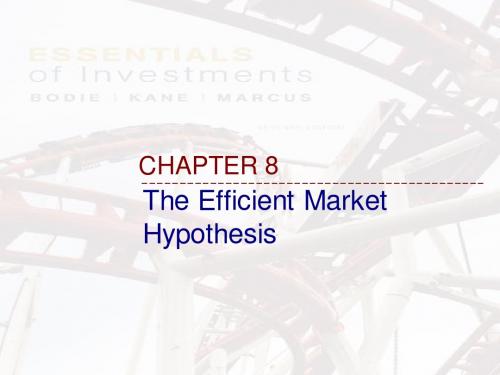
At first, some economists treated these results from the irrationality of the market
– Because they believe that just like to predict the business cycle, it is possible to predict stock prices
8-7
Figure 8.1 Cumulative Abnormal Returns For Takeover Attempts
※ In most takeovers, the acquiring firm pays a substantial premium over current market prices of the merged firm ※ The figure shows that the announcement of a takeover attempt should cause the stock price of the merged firm to jump immediately ※ In addition, there is no further drift in prices after the announcement date, including the day on which the takeover transaction is physically completed
8-6
Efficient Market Hypothesis (EMH)
The Efficient Market Hypothesis (EMH) (效率市 (效率市 場假說) 場假說)
– The notion that current stock prices fully reflect all available information is referred to as the efficient market hypothesis – In other words, if the stock prices can reflect new information immediately, then the market is efficient – The pursuance of profit and the competition among investors are sources of efficiency – Therefore, randomly evolving stock prices are the necessary consequence of investors competing to discover relevant information and trading stocks based on this information
兹维博迪金融学第二版课件

THANK YOU
发展
金融市场的发展趋势包括电子化 、全球化、金融创新等,这些趋 势对金融市场的运行机制和监管 提出了新的挑战和要求。
02
货币与银行
货币的定义与职能
总结词
货币的定义与职能
详细描述
货币是交换媒介和价值尺度,具有流通、支付、贮藏和世界货币等职能。
银行的定义与类型
总结词
银行的定义与类型
详细描述
银行是经营货币信用的金融机构,分为中央银行、政策性银行、商业银行、投资 银行等类型。
02
马科维茨投资组合理论
通过构建有效的投资组合,实现风险和收益的平衡。
03
资本资产定价模型(CAPM)
评估不同资产类别的风险和预期收益之间的关系。
04
金融衍生品市场
金融衍生品的定义与类型
总结词
详细描述金融衍生品的定义,以及不同 类型的金融衍生品(如期货、期权、远 期合约、互换等)的特点和用途。
VS
保险公司的业务与管理
总结词
保险公司的业务与管理
详细描述
保险公司的业务主要包括保险产品的开发、销售、理赔 和投资等。在业务管理方面,保险公司需要制定合理的 保费和赔付标准,建立完善的销售渠道和理赔流程,以 及进行有效的投资管理。此外,保险公司还需要加强风 险管理,控制保费、赔付和投资等方面的风险,以保证 公司的稳健经营。
投资定义
投资是指为了获得未来的收益而将资金或其他资源投入某一领域或项目。
实物投资
如房地产、机器设备等。
金融投资
如股票、债券、基金、期货、期权等。
人力资本投资
如教育、培训等。
股票投资
01
02
03
股票定义
博迪《金融学》(第2版)笔记和课后习题详解修订版答案

博迪《金融学》(第2版)笔记和课后习题详解(修订版)完整版>精研学习䋞>无偿试用20%资料全国547所院校视频及题库全收集考研全套>视频资料>课后答案>往年真题>职称考试第1部分金融和金融体系第1章金融学1.1复习笔记1.2课后习题详解第2章金融市场和金融机构2.1复习笔记2.2课后习题详解第3章管理财务健康状况和业绩3.1复习笔记3.2课后习题详解第2部分时间与资源配置第4章跨期配置资源4.1复习笔记4.2课后习题详解第5章居民户的储蓄和投资决策5.1复习笔记5.2课后习题详解第6章投资项目分析6.1复习笔记6.2课后习题详解第3部分价值评估模型第7章市场估值原理7.1复习笔记7.2课后习题详解第8章已知现金流的价值评估:债券8.1复习笔记8.2课后习题详解第9章普通股的价值评估9.1复习笔记9.2课后习题详解第4部分风险管理与资产组合理论第10章风险管理的原理10.1复习笔记10.2课后习题详解第11章对冲、投保和分散化11.1复习笔记11.2课后习题详解第12章资产组合机会和选择12.1复习笔记12.2课后习题详解第5部分资产定价第13章资本市场均衡13.1复习笔记13.2课后习题详解第14章远期市场与期货市场14.1复习笔记14.2课后习题详解第15章期权市场与或有索取权市场15.1复习笔记15.2课后习题详解第6部分公司金融第16章企业的财务结构16.1复习笔记16.2课后习题详解第17章实物期权17.1复习笔记17.2课后习题详解。
兹维博迪金融学第二版课件

债券价值的企业决策
兹维博迪金融学第二版
19
• 营运资本
• 所有企业(包括那些盈利很好的企业),如果不对营运 资本管理足够重视,就可能承受严重损失。现金的流入 流出在时间上并非完全匹配。为了为现金流赤字融资, 为现金流盈余找到好的投资项目,管理者必须关心向客 户收款和及时支付账单。
议? • 一个拉美国家申请为其大项目贷款。你所在的组织应
该贷给它吗?
兹维博迪金融学第二版
7
1.1 定义金融学
• 金融学是对人们怎样跨时配置稀缺资源的研究。 金融决策区别于其他资源配置决策的两个特征:
• 成本和收益的跨时配置 • 未来现金流实际的时序和规模经常只能以一定概
率知道,而不能完全确知பைடு நூலகம்
• 理解金融学帮助你评估这些不确定的现金流
兹维博迪金融学第二版
16
• 资本预算过程
• 准备一个计划,以获取实施战略规划的厂房、机器、实验室、展厅、仓 库和人力资本。
• 基本分析单位是投资项目。资本预算过程中,投资项目被识别、排优先 序和实施。
兹维博迪金融学第二版
17
• 融资过程
• 一旦企业已决定准备实施的新项目,这些项目就必须用未 分配利润、普通股、优先股、债券、可转换证券、银行贷 款、雇员股票期权、租赁合约、退休金债务等等来融资。
• 资本结构是企业市场价值归入每一类已发行证券的数量。 它决定企业未来现金流的归属和风险水平【如股票融资对 企业没有撤资风险,债务融资有】
• 资本结构的分析单位是作为整体的企业,而不是一个投资 项目。
兹维博迪金融学第二版
18
• 资本结构也决定了不同的可能性下由谁控制企 业。
滋维博迪投资学Chap.ppt
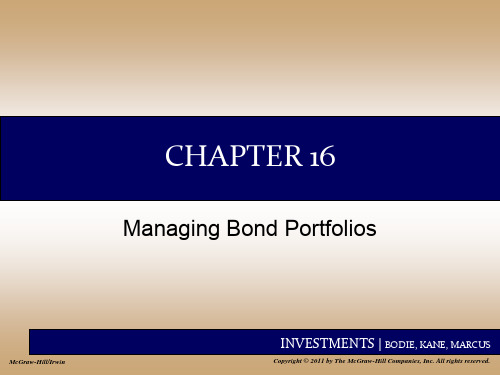
INVESTMENTS | BODIE, KANE, MARCUS
16-14
Rules for Duration
Rule 4 Holding other factors constant, the duration of a coupon bond is higher when the bond’s yield to maturity is lower
Rules 5 The duration of a level perpetuity is equal to: (1+y) / y
• Bonds with greater curvature gain more in price when yields fall than they lose when yields rise.
• The more volatile interest rates, the more attractive this asymmetry.
(y)2
]
INVESTMENTS | BODIE, KANE, MARCUS
16-20
Figure 16.4 Convexity of Two Bonds
INVESTMENTS | BODIE, KANE, MARCUS
16-21
Why do Investors Like Convexity?
• Bonds with greater convexity have more curvature in the price-yield relationship.
《金融学教学课件》bodie2e_chapter09.ppt

6 Copyright © 2009 Pearson Education, Inc. Publishing as Prentice Hall
Reading Stock Listings
– Hi = 115: Highest share price of the day – Lo = 113: Lowest share price of the day – Close = 114 3/4: Days closing share price – Chg = 1 3/8: Change in closing price from
16
Vol 100 14591
Day Hi Day Lo Close Net Chg
115 113 114 3/4 +1 3/8
4 Copyright © 2009 Pearson Education, Inc. Publishing as Prentice Hall
Reading Stock Listings
multiple approach 9.5 Does dividend policy affect shareholder
wealth?
2 Copyright © 2009 Pearson Education, Inc. Publishing as Prentice Hall
9.1 Reading Stock Listings
3 Copyright © 2009 Pearson Education, Inc. Publishing as Prentice Hall
Reading Stock Listings
兹维博迪金融学第二版课件Chapter

期货
标准化合约,高杠 杆交易,风险较大 。
股票
代表公司所有权, 收益不确定,风险 较大。
基金
集合投资工具同货币之间的兑 换,受汇率波动影 响。
金融衍生品的种类与功能
01
期权
购买或出售某资产的权利,风险有 限,收益无限。
互换
交换不同种类的现金流,如利率互 换和货币互换。
05
资本资产定价模型与 有效市场假说
资本资产定价模型的概念与应用
资本资产定价模型( CAPM)
该模型用于评估风险和预期回报之间的关系 ,通过将投资组合的风险分为系统风险和非 系统风险,为投资者提供了一种评估风险溢 价的工具。
应用
CAPM在投资组合管理、资本预算和公司财 务等领域有着广泛的应用,帮助投资者理解 风险和回报的关系,并制定有效的投资策略
行为金融学
该学科研究投资者行为和市场异 常现象,通过分析投资者心理和 行为偏差,解释市场异常现象的 原因。
应用
行为金融学为投资者提供了新的 视角和工具,帮助投资者理解市 场行为,制定更加理性的投资策 略。
06
公司金融
公司融资的种类与方式
内部融资
公司使用内部产生的现金流来为其投资提供 资金,如折旧和留存收益。
利率的风险与回报关系
利率风险
由于市场利率的变动,投资者的收益 也会受到影响。如果市场利率上升, 债券价格将下降,反之亦然。因此, 投资者需要承担市场利率变动的风险 。
回报与风险关系
投资回报与风险之间存在正相关关系 。高回报往往伴随着高风险,而低风 险则可能带来较低的回报。投资者需 要根据自身的风险承受能力和投资目 标选择合适的投资产品。
04
投资组合理论
投资组合的构建与优化
兹维博迪金融学第二版Chapter10PPT课件
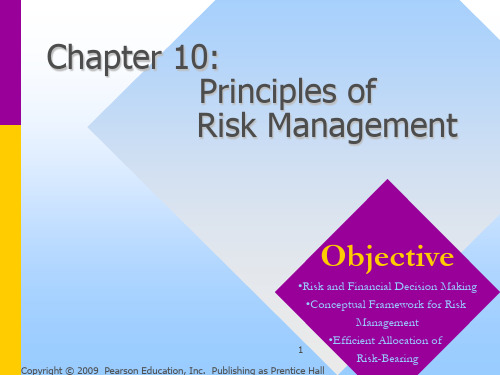
– Hedge with contracts to third parties, (radio station, concessionaires, contractors, …)
1
Risk-Bearing
Copyright © 2009 Pearson Education, Inc. Publishing as Prentice Hall
Chapter 10 Contents
• 10.1 What is Risk? • 10.2 Risk and Economic Decisions • 10.3 The Risk-Management Process • 10.4 The Three Dimensions of Risk Transfer • 10.5 Risk Transfer and Economic Efficiency • 10.6 Institutions for Risk Management • 10.7 Portfolio Theory: Quantitative Analysis
10.1 What is Risk?
• Uncertainty
– An unrealized event is uncertain for an observer at a given time if he/she does not know its outcome at that time
– I enter a sealed bid on a public contract
for Optimal Risk Management • 10.8 Probability Distributions of Returns • 10.9 Standard Deviation as a Measure of Risk
《金融学教学课件》bodie2e_chapter0965页PPT
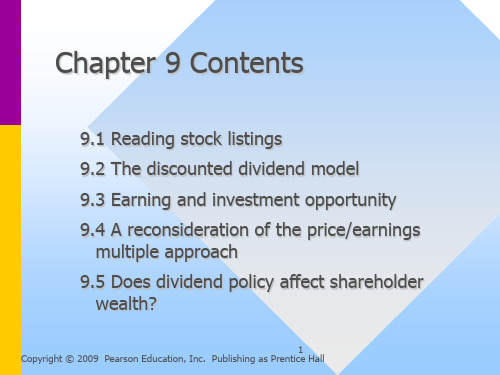
• The listing is for IBM, which is traded on the New York Stock Exchange
2 Copyright © 2009 Pearson Education, Inc. Publishing as Prentice Hall
Reading Stock Listings
Yr Hi Yr Lo Stock Sym 123 1/8 93 1/8 IBM IBM
Div
Yld % PE
4.84 4.2
Chapter 9 Contents
9.1 Reading stock listings 9.2 The discounted dividend model 9.3 Earning and investment opportunity 9.4 A reconsideration of the price/earnings
previous trading day
6 Copyright © 2009 Pearson Education, Inc. Publishing as Prentice Hall
Observation
• It is usual to trade shares in round lots of
100 shares
• Equivalently, we start with the discounted cash flow model, and obtain the holding period return
金融学原理兹维博迪
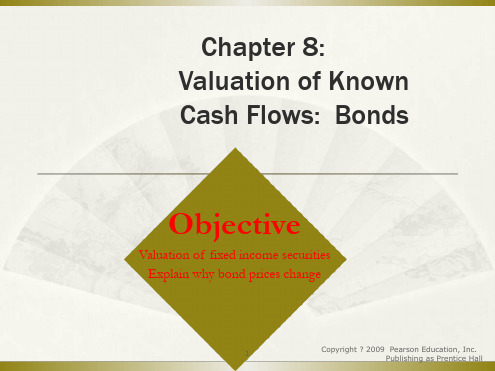
*?? 1 ?1?
i
1
? ? ?
?
pmt2
*?? 1 ?1?
i
2
? ? ?
? ...?
pmtn?1
*?? 1 ?1?
i
n?1
? ? ?
?
pmtn
*?? 1 ?1?
i
n
? ? ?
8
Copyright ? 2009 Pearson Education, Inc. Publishing as Prentice Hall
An increase in the required rate of return always leads to a decrease in the value of a fixed income security
? The proof is very easy
7
Copyright ? 2009 Pearson Education, Inc. Publishing as Prentice Hall
Bond Prices Rise as the Interest Rates Fall
? If i goes up, 1+i goes up, 1/(1+i) goes down for i > -1, (1/(1+i))j goes down for i > 0. So if the payments are positive, then the sum must also go down
8.1 Using Present Value Formulas to
Value Known Flows
? You have been offered the opportunity to purchase a mortgage. The remaining life of the mortgage is 60 months, with payment of $400. Your required rate of return is 1.5% / month.
金融学第1、2章金融学 (第二版 兹维.博迪 罗伯特C默顿等著)
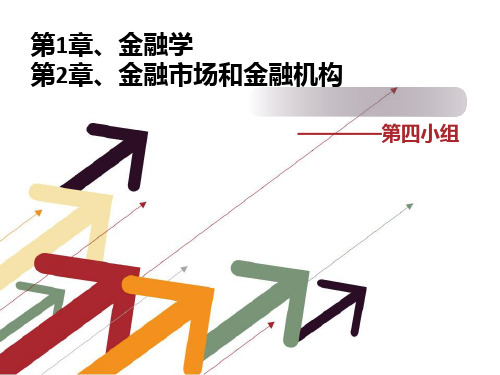
2.3.5 功能5 :提供信息
金融体系可以提供有助于在不同经济部门中协调分 散性决策的价格信息。 如:你和你姐姐继承了一个家族的企业,并且它将 在你们之间平均分配。你们并不希望出售它,因为 你们中的一位希望继续经营该企业。另一位应当获 得多少?显然,了解类似资产的市场价格横了另一 位获得多少是非常有用的。
企业(厂商的简称):基本功能为生 产产品和服务的实体。
企业金融(或公司金融):研究企业金融 决策的金融学分支。
资本:物质资本和金融资本。 1、物质资本:厂房、机器设备以及再生产 过程中使用的其他中间投入品。 2、金融资本:股票、债券以及用来为获取 物质资本提供融资的贷款。
企业必然做出的四类基本金融决策:
相关例子
假定你是一个公司的管理者,现在你面临两 项可相互代替的投资方式,一项是投资于 一个旅游城市的大型游乐场建设,成本回 收时间较慢,但该项投资比较安全。另一 项是投资于一个处于偏远郊区的别墅群建 设,如果能在短时间内售出,回报率非常 高,如果不能在短时间售出,则会影响公 司的资金周转,该项投资风险大。
2.2资金流动
通过金融体系从拥有资金盈余的主体流向存在 赤字的主体。 金融市场
盈余单位 金融中介 赤字单位
2.3从功能出发的视觉 2.3.1 功能1:跨期转移资源 金融体系提供了跨期转移资源,跨国界转移 资源以及跨行业转移经济资源的方式。 金融体系也在将资源从一地转移至另一地的 过程中发挥着重要作用。
兹维博迪金融学第二版试题库08TB备课讲稿
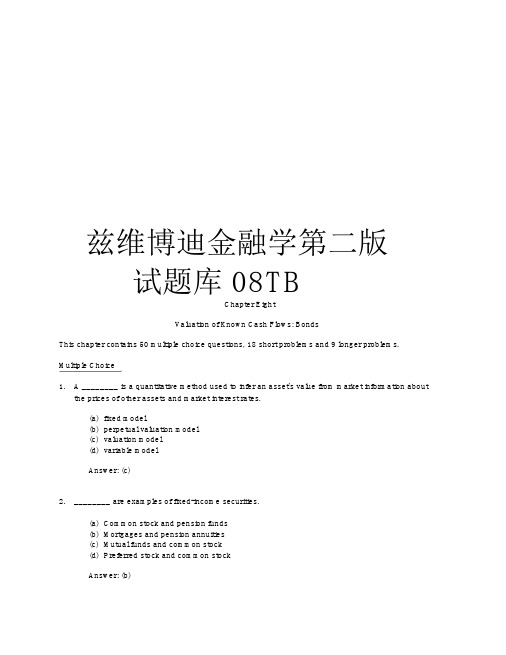
兹维博迪金融学第二版试题库 08TBChapter EightValuation of Known Cash Flows: BondsThis chapter contains 50 multiple choice questions, 18 short problems and 9 longer problems. Multiple Choice1. A ________ is a quantitative method used to infer an asset's value from market information aboutthe prices of other assets and market interest rates.(a)fixed model(b)perpetual valuation model(c)valuation model(d)variable modelAnswer: (c)2.________ are examples of fixed-income securities.(a)Common stock and pension funds(b)Mortgages and pension annuities(c)Mutual funds and common stock(d)Preferred stock and common stockAnswer: (b)3.Consider a fixed-income security that promises to pay $150 each year for the next five years. Howmuch is this five-year annuity worth if the appropriate discount rate is 7% per year?(a)$534.74(b)$615.03(c)$802.50(d)$867.96Answer: (b)仅供学习与交流,如有侵权请联系网站删除谢谢 24.Consider a fixed-income security that promises to pay $120 each year for the next four years.Calculate the value of this four-year annuity if the appropriate discount rate is 6% per year.(a)$415.81(b)$508.80(c)$531.85(d)$629.06Answer: (a)5.The price of any existing fixed-income security ________ when market interest rates rise becauseinvestors will only be willing to ________ them if they offer a competitive yield.(a)rises; buy(b)rises; sell(c)falls; buy(d)falls; sellAnswer: (c)6. A fall in interest rates causes a ________ in the market value of a fixed-income security.(a) a rise(b) a fall(c)no change(d)it cannot be determined from the information givenAnswer: (a)7. A change in market interest rates causes ________ in the market values of all existingcontracts promising fixed payments in the future.(a) a change in the same direction(b) a change in the opposite direction(c)no change(d)an unpredictable variationAnswer: (b)仅供学习与交流,如有侵权请联系网站删除谢谢 38.What happens to the value of a four-year fixed-income security promising $100 per year if themarket interest rate rises from 5% to 6% per year?(a) A rise of 1% causes a drop of $4.87 in market value.(b) A rise of 1% causes a rise of $4.87 in market value.(c) A rise of 1% causes a drop of $8.09 in market value.(d) A rise of 1% causes a rise of $8.09 in market value.Answer: (c)9.What happens to the value of a four-year fixed-income security promising $100 per year if themarket interest rate falls from 6% to 5% per year?(a) A fall of 1% causes a drop of $4.87 in market value.(b) A fall of 1% causes a rise of $4.87 in market value.(c) A fall of 1% causes a drop of $8.09 in market value.(d) A fall of 1% causes a rise of $8.09 in market value.Answer: (d)10.A zero-coupon bond is also known as ________.(a) a perpetual bond(b) a pure discount bond(c) a market rebate(d)an infinite bondAnswer: (b)11.The promised cash payment on a pure discount bond is called its ________.(a)face value(b)par value(c)fixed interest(d)both a and bAnswer: (d)仅供学习与交流,如有侵权请联系网站删除谢谢 412.What is the yield of a 1-year pure discount bond with a price of $850 and a face value of $1,000?(a)8.50%(b)9.09%(c)15.00%(d)17.65%Answer: (d)13.What is the yield of a 1-year pure discount bond with a price of $900 and a face value of $1,000?(a) 5.26%(b)10.00%(c)11.11%(d)15.79%Answer: (c)14.Consider a four-year pure discount bond with a face value of $1,000. If its current price is $850,compute its annualized yield.(a) 1.17%(b) 4.15%(c) 5.57%(d)17.60%Answer: (b)15.Consider a three-year pure discount bond with a face value of $1,000. If its current price is $900,compute its annualized yield.(a) 1.036%(b) 1.111%(c) 3.57%(d) 5.41%Answer: (c)仅供学习与交流,如有侵权请联系网站删除谢谢 516.Consider a five-year pure discount bond with a face value of $1,000. If its current price is $780, whatis its annualized yield?(a) 5.09%(b) 2.82%(c) 1.28%(d) 1.05%Answer: (a)17.A ________ obligates the issuer to make periodic payments of interest to the bondholder for the lifeof the bond and then to pay the face value of the bond when the bond matures.(a)pure discount(b)zero-coupon(c)perpetual bond(d)coupon bondAnswer: (d)18.The ________ of the bond is interest rate applied to the ________ of the bond to compute theperiodic payment.(a)coupon rate; face value(b)maturity rate; face value(c)coupon rate; price(d)maturity rate; priceAnswer: (a)19.For a bond with a face value of $1,000 and coupon rate of 11%, what is the annual coupon payment?(a)$100(b)$110(c)$1,000(d)$1,100Answer: (b)仅供学习与交流,如有侵权请联系网站删除谢谢 620.For a bond with a face value of $1,000 and a coupon rate of 9%, what is the annual coupon payment?(a)$90(b)$99(c)$1,000(d)$1,190Answer: (a)21.If the market price of a coupon bond equals its face value, it is also termed a ________.(a)par bond(b)premium bond(c)discount bond(d)zero-discount bondAnswer: (a)22. If the bond’ s market price is higher than its face value, it is termed a.(a)par bond(b)premium bond(c)discount bond(d)zero-discount bondAnswer: (b)23. If the bond’ s market price is lower than its face value, it is termed a.(a)par bond(b)premium bond(c)discount bond(d)zero-par bondAnswer: (c)仅供学习与交流,如有侵权请联系网站删除谢谢 724.If a bond selling for $850 has an annual coupon payment of $80 and a face value of $1,000, what isits current yield?(a)8.00%(b)9.41%(c)17.65%(d)27.05%Answer: (b)25.If a bond selling for $1,120 has an annual coupon payment of $110 and a face value of $1,000, whatis its current yield?(a)8.90%(b)9.82%(c)10.71%(d)11.00%Answer: (b)26.If a bond selling for $900 has an annual coupon payment of $80 and a face value of $1,000, what isits current yield?(a)8.00%(b)8.89%(c)11.00%(d)20.00%Answer: (b)27. The ________ is the discount rate that makes the present value of the bond am of promised’scashstrepayments equal to its price.(a) compound rate(b) yield to maturity(c) coupon rate(d) current yieldAnswer: (b)仅供学习与交流,如有侵权请联系网站删除谢谢 828.Suppose you are considering buying a one-year 11% coupon bond with a face value of $1,000 anda current price of $1,020. What is its yield to maturity?(a)8.82%(b)9.00%(c)10.78%(d)11.00%Answer: (a)29.Suppose you are considering buying a one-year 11% coupon bond with a face value of $1,000 anda current price of $1,050. What is its yield to maturity?(a) 4.76%(b) 5.71%(c) 6.00%(d)10.48%Answer: (b)30.Suppose you are considering buying a five-year 11% coupon bond with a face value of $1,000 and acurrent price of $950. What is its yield to maturity?(a) 5.62%(b)9.63%(c)11.58%(d)12.40%Answer: (d)31.Suppose you are considering buying a five-year 11% coupon bond with a face value of $1,000 and acurrent price of $1,100. What is its yield to maturity?(a) 3.87%(b)8.47%(c)10.00%(d)13.62%Answer: (b)仅供学习与交流,如有侵权请联系网站删除谢谢 932.Suppose you are considering buying a six-year 10% coupon bond with a face value of $1,000 anda current price of $1,100. What are the current yield and yield to maturity of this bond?(a)CY = 11.00%; YTM = 12.23%(b)CY = 12.23%; YTM = 11.00%(c)CY = 7.85%; YTM = 9.09%(d)CY = 9.09%; YTM = 7.85%Answer (d)33.Suppose you are considering buying a seven-year 11% coupon bond with a face value of $1,000 anda current price of $950. What are the current yield and yield to maturity of this coupon bond?(a)CY = 12.10%; YTM = 11.58%(b)CY = 11.58%; YTM = 12.10%(c)CY = 9.92%; YTM = 10.45%(d)CY = 10.45%; YTM = 9.92%Answer: (b)34.Over time bond prices ________ their face value. Before maturity, bond prices can ________ agreat deal as a result of changes in market interest rates.(a)diverge from; fluctuate(b)converge toward; flatten out(c)converge toward; fluctuate(d)diverge from; flatten outAnswer: (c)35.When the yield curve is not flat, bonds of the same ________ with different coupon rates have________ yields to maturity.(a)maturity, different(b)maturity, identical(c)callability, different(d)callability, identicalAnswer: (a)仅供学习与交流,如有侵权请联系网站删除谢谢 1036.Bonds offering the same future stream of promised payments can differ in a number of ways, but thetwo most important are ________ and ________.(a)taxability, issue origin(b)type of issuer, default risk(c)type of issuer, taxability(d)taxability, default riskAnswer: (d)37.A ________ is one that gives the holder of a bond issued by a corporation the right to convert thebond into a pre-specified number of shares of common stock.(a)callable bond(b)convertible bond(c)stock bond(d)preferred bondAnswer: (b)38.A ________ is one that gives the issuer of the bond the right to redeem it before the finalmaturity date.(a)callable bond(b)convertible bond(c)stock bond(d)preferred bondAnswer: (a)39.Five years ago, English and Co. issued 25-year coupon bonds with par value $1,000. At the time ofissuance, the yield to maturity was 6 percent and the bonds sold at par. The bonds are currently selling at 110 percent of their par value. Assuming that the coupon is paid annually, what is the current yield to maturity?(a) 3.77%(b) 5.18%(c) 5.27%(d) 5.46%Answer: (b)仅供学习与交流,如有侵权请联系网站删除谢谢 1140.Potemkin Corporation plans to raise $10,000,000 in funds by issuing zero coupon $1,000 par valuebonds with a 25 year maturity. Potemkin Corporation is able to issue these bonds at an after tax cost of debt of 12%. To the nearest whole number, how many bonds must Potemkin Corporation issue?(a)10,000 bonds(b)42,919 bonds(c)125,837 bonds(d)170,000 bondsAnswer: (d)41.Calculate the years to maturity for a bond based on the following information. The bond trades at$950, it has a par value of $1,000, a coupon rate of 11%, and a required rate of return of 12%.(a)8 years(b)12 years(c)15 years(d)16 yearsAnswer: (a)pute the current price of Walsingham bonds based on the following information. Walsinghambonds have a $1,000 par value, have 20 years remaining until maturity, a 12 percent coupon rate, and a yield to maturity of 10.5 percent.(a)$858.42(b)$982.47(c)$1,119.52(d)$1,124.41Answer: (d)pute the yield to maturity of Arundel bonds based on the following information. Arundel bondshave a $1,000 par value, 25 years remaining until maturity, an 11% coupon rate, and a current market price of $1,187.(a) 4.55%(b)9.08%(c)9.27%(d)13.17%Answer: (b)仅供学习与交流,如有侵权请联系网站删除谢谢 1244.When prices of U.S Treasury strips are listed, principal from a Treasury bond is denoted by the letters________.(a)ci(b)tb(c)bp(d)npAnswer: (c)45.The ________ is the price at which dealers in Treasury bonds are willing to sell.(a)bid price(b)asked yield(c)ask price(d)maturity priceAnswer: (c)46.The ________ is the price at which dealers are willing to buy.(a)bid price(b)ask price(c)asked yield(d)maturity priceAnswer: (a)47.The bid price of a bond is always ________ the ask price.(a)greater than(b)less than(c)identical to(d)it varies from case to caseAnswer: (b)仅供学习与交流,如有侵权请联系网站删除谢谢 1348.The ________ of a bond price measures the sensitivity of the bond price to a change in the yieldto maturity.(a)callability(b)convertibility(c)immutability(d)elasticityAnswer: (d)49.Suppose you buy a 25-year pure discount bond with a face value of $1,000 and a yield of 6% per year.A day later market interest rates drop to 5% and so does the yield on your bond. What is theproportional change in the price of your bond?(a) a decrease of 26.74%(b) a decrease of 21.10%(c)an increase of 26.74(d)an increase of 21.20Answer: (c)50.Suppose you buy a 25-year pure discount bond with a face value of $1,000 and a yield of 6% per year.A day later market interest rates rise to 5% and so does the yield on your bond. What is the elasticityof the bond price to the change in the yield?(a)–0.62%(b)–1.27%(c)–1.60%(d)–2.67%Answer: (c)仅供学习与交流,如有侵权请联系网站删除谢谢 14Short Problems1.Consider a five-year fixed-income security which promises $120 per year. Calculate the value ofthe security if the market interest rate rises from 5% to 6% per year.Answer :n i PV PMT Result55?$120PV = $519.54n i PV PMT Result56?$120PV = $505.48The price drops by $14.06.2.Consider a four-year fixed-income security which promises $120 per year. Calculate the value of thesecurity if the market interest rate falls from 7% to 6% per year.Answer :n i PV PMT Result47?$120PV = $406.47n i PV PMT Result46?$120PV = $415.81The price increases by $9.34.3.Discuss the general principles about the relation between prices and yields of coupon bonds.Answer:Principle #1: Par Bonds.If a bond's price equals its face value, then its yield equals its coupon rate.Principle #2: Premium Bonds.If a coupon bond has a price higher than its face value, its yield to maturity is less than its current yield, which is in turn less than its coupon rate.Principle #3: Discount Bonds.If a coupon bond has a price lower than its face value, its yield to maturity is greater than its current yield, which is in turn greater than its coupon rate.仅供学习与交流,如有侵权请联系网站删除谢谢 154.List some reasons why differences in the prices of fixed-income securities of a given maturity mayarise.Answer :Differences in the prices of fixed-income securities of a given maturity may arise due to differences in coupon rates, default risk, tax treatment, callability and convertibility.5.Explain why it is important to have a method for valuation of fixed-income contracts.Answer :(1)The parties to the contracts need to have an agreed-upon valuation procedure insetting the terms of the contracts at the outset.(2)Since market factors determining the value of fixed-income contracts changeover time, both buyers and sellers have to reevaluate them each time they are traded.6.Consider a five-year pure discount bond with a face value of $1,000. If its current price is $775,compute its annualized yield.Answer :n i PV FV Result5?–$775$1,000i = 5.23%7. A four-year bond has a coupon rate of 6% per year, a price of $950, and a face value of $1,000.Calculate its current yield and yield to maturity.Answer :Current yield= coupon/price= 60/950= 6.32%To calculate yield to maturity:n i = YTM PV FV PMT Result4?–$950$1,000$60YTM = 7.49%仅供学习与交流,如有侵权请联系网站删除谢谢 168.What is the current price of a bond that has a coupon rate of 7%, a return rate of 8%, and a facevalue of $1,000? Assume that this bond will mature in five years. Compare the current price of the bond against its face value.Answer :n i = YTM PV FV PMT Result58?$1,000$70PV = $960.07Because the price of the bond is below its face value, it is a discount bond.9. A five-year coupon bond has a coupon rate of 5%, a return rate of 6%, and a face value of $1,000.What is its current price and how does it compare to its face value?Answer :n i = YTM PV FV PMT Result56?$1,000$50PV = $957.88Because the price of the bond is below its face value, it is a discount bond.10.What is the yield to maturity of a five-year coupon bond with a current price of $850, a face value of$1,000, and coupon rate of 7%?Answer :n i = YTM PV FV PMT Result5?–$850$1,000$70YTM = 11.07%11.Five years ago, English and Co. issued 30 year coupon bonds with a par value of $1,000. At thetime of issuance, the yield to maturity was 6 percent per year and the bonds sold at par. The bonds are currently selling at 85 percent of their par value. Assuming that the coupon is paid annually, what is the current yield to maturity?Answer :Five years ago, the bonds were issued at par, which means at the time yield to maturity equaled coupon rate. So the annual coupon is 0.06 x $1,000 = $60.For the current yield to maturity:n i = YTM PV FV PMT Result25?–8501,00060YTM = 7.33%仅供学习与交流,如有侵权请联系网站删除谢谢 1712.Eisenstein Corporation plans to raise $100,000,000 in funds by issuing zero-coupon $1,000 par valuebonds with a 30-year maturity. Assuming that Eisenstein Corporation is able to issue these bonds at an after-tax cost of debt of 11%, how many bonds must Eisenstein Corporation issue?Answer :First, calculate the price of an Eisenstein bond:n i = YTM PV FV PMT Result3011?1,0000PV = $43.68The corporation wants to raise $100,000,000, so it must issue the following number of bonds:$100,000,000/$43.68 = 2,289,377 bonds13.Currently, an Eisenstein bond trades at $1,050 per bond and has a coupon rate of 10%. Assumingthe bond matures at a $1,000 value, and the required rate of return is 9.5%, in how many years does an Eisenstein bond mature?Answer :n i = YTM PV FV PMT Result?9.5–1,0501,0000n = 33pute the current price of Walsingham bonds based on the following information. Walsinghambonds have a $1,000 par value, 26 years remaining until maturity, a 13 percent coupon rate, anda current yield to maturity of 11 percent per year.Answer :n i = YTM PV FV PMT Result2611?1,0000PV = $1,169.6915.Health & US Corporation is a major pharmaceutical firm that has recently experienced a marketreevaluation. Currently, the firm has a bond issue outstanding with 18 years to maturity and a coupon rate of 9 percent, with interest paid annually. The required rate of return of this debt issue has risen to15 percent. Calculate the current price of this bond.Answer :n i = YTM PV FV PMT Result1815?1,00090PV = $632.32仅供学习与交流,如有侵权请联系网站删除谢谢 1816.Calculate the coupon rate, current yield, and the yield to maturity for a bond that has $1,000 par value,pays a coupon of $85 annually, matures in 20 years, and has a current price of $985.25.Answer :Coupon rate = 85/1,000=8.5% per yearCurrent yield = coupon/price=85/985.25=8.63%For yield to maturity:n i = YTM PV FV PMT Result20?–985.251,00085YTM = 8.66%17.Suppose you buy a 20-year pure discount bond with a face value of $1,000 and a yield of 7% per year.A day later, market interest rates rise to 8% and so does the yield of your bond. What is theproportional change in the price of your bond? What is the elasticity of the bond price to the change in the yield?Answer :n i = YTM PV FV PMT Result207?1,0000PV = $258.42n i = YTM PV FV PMT Result208?1,0000PV = $214.55The price of the bond decreased by $43.87, so the proportional decline in price is$43.87/$258.42 = 16.98%.Elasticity is % change in price over % change in YTM, or–16.98%/14.29% =–1.19.18. As of today, January 1, 2009, Flanders Corporation is holding $10,000,000 in long-term debt at parbonds. The bonds have a par value of $1,000, mature on January 1, 2019, and pay a 5 percent coupon.Calculate the current market value of Flanders’ debt,maturityiftheisyield7percentto.Answer :Total number of bonds = $10,000,000/$1,000 = 10,000 bondsn i PV FV PMT Result107?1,00050PV = $859.50The current market value= $859.50 x 10,000= $8,578,800仅供学习与交流,如有侵权请联系网站删除谢谢 19精品资料Longer Problems1.Consider the purchase of a 30-year pure discount bond with a face value of $1,000 and a yield of 7%per year. A week later the market interest rate rises to 8% and o does the yield on your bond.Calculate the proportional change in the price of the bond. What basic principle in valuation of known cash flows does this illustrate?Answer :n i PV FV Result307?$1,000PV = $131.37n i PV FV Result308?$1,000PV = $99.38The price drops by $31.99, so a rise of 1% in market interest rates results in a $31.99/$131.37 =24.35% drop in the price of the bond. The general principle illustrates is that a change in marketinterest rates causes a change in the opposite direction in the market value of the bonds.2.Suppose our want to know the price of a 15-year 8% coupon bond which pays interest annually. Theface value of the bond is $1,000.(a)You have been told the yield to maturity is 9%. What is the price? Assume couponsare paid annually.(b)What is the price if coupons are paid semi-annually and the yield to maturity is 9%per year?Answer :(a)If coupons are paid annually:n i PV FV PMT Result159?$1,000$80PV = $919.39(b)If coupons are paid semi-annually:n i PV FV PMT Result30 4.5?$1,000$40PV = $918.563. A media report recently stated that prices of 30-year treasury bonds increased substantially becauseinflation was falling and the Federal Reserve was not expected to increase interest rates. How would you describe this interpretation using discounted cash flow techniques?Answer :Inflation is a component of i, the required return on bonds, so when inflation decreases,i decreases and bond prices rise.仅供学习与交流,如有侵权请联系网站删除谢谢 204.Suppose you want to know the price of a 10-year 7% coupon bond which pays interest annually.The face value of the bond is $1,000.(a)What is the price of this bond if the yield to maturity is 8%?(b)What is the current yield of this coupon bond?(c)What is the price of this bond if coupons are paid semi-annually and the yield tomaturity is 8%?Answer :a.n i PV FV PMT Result108?$1,000$70PV = $932.90b.Current yield= coupon/price=70/932.9=7.5%c.n i PV FV PMT Result204?$1,000$35PV = $932.055.Suppose you buy a 30-year pure discount bond with a face value of $1,000 and a yield of 9% per year.A day later, market interest rates fall to 8% and so does the yield of your bond. What is theproportional change in the price of your bond? What is the elasticity of the bond price to the change in the yield?Answer :n i = YTM PV FV PMT Result309?1,0000PV = $75.37n i = YTM PV FV PMT Result308?1,0000PV = $99.38The price of the bond decreased by $24.01, so the proportional increase in price is$24.01/$75.37 = 31.86%.Elasticity is % change in price over % change in YTM, or 31.86%/ –11.11% = –2.87.仅供学习与交流,如有侵权请联系网站删除谢谢 216.As part of a reorganization plan, a bankruptcy court has permitted a new indenture on anoutstanding bond issue to be put into effect for Leicester Corporation, which recently filed forbankruptcy. It is known that the issue has $1,000 par value per bond, 15 years to maturity, and a coupon rate of 11 percent paid annually. The reorganization plan allows the following arrangement: In years 1 through 7, there will be no coupon paid (that is, coupon = $0). In years 8 through 15, regular coupon payments will resume. At maturity in year 15, the par value plus the sum of all coupon payments that were not paid during years 1 through 7 must be paid. However, no interest will be paid on the deferred coupon payments. If the required rate of return is 18 percent, calculate the current price the Leicester bonds would sell for in the market.Answer :Coupon= 0.11 x 1000= $110 per yearSet up a table of cash flow obligations over the next 15 years.Year Cash Flow1020304050607081109110101101111012110131101411015110 + $1000 (par) + $770 (deferredcoupons) = $1,880The present value of this cash flow stream, using a discount rate of 18%, is $288.62 per bond.仅供学习与交流,如有侵权请联系网站删除谢谢 227.The Dharma Corporation has recently experienced a market reevaluation. Currently, the firm has abond issue outstanding with 18 years to maturity, a face value of $1,000, and a coupon rate of 10 percent paid annually. The required rate of return on this debt issue has risen to 16 percent.Calculate the current price of this bond.Answer :n i = YTM PV FV PMT Result1816?1,000100PV = $650.928.Calculate the coupon rate, current yield, and the yield to maturity for a bond that has $1,000 par value,pays $95 interest annually, matures in 25 years, and has a current price of $1,087.75.Answer :Coupon rate = 95/1,000= 9.5% per yearCurrent yield = coupon/price=95/1,087.75=8.73%To calculate yield to maturity:n i = YTM PV FV PMT Result25?–1,087.751,00095YTM = 8.63%9.As of today, January 1, 2009, Gala Worldwide is holding $1,000,000 in long-term debt at par bonds.The bonds have a par value of $1,000, mature on January 1, 2029, and pay a 7 percent coupon.Calculate the current market value of Flanders’ debt, if the yield to maturity is 8 percent.Answer :Total number of bonds = $100,000,000/$1,000 = 100,000 bondsn i PV FV PMT Result208?1,00070PV = $901.85The current market value= $901.85 x 100,000= $90,185,000仅供学习与交流,如有侵权请联系网站删除谢谢 23。
- 1、下载文档前请自行甄别文档内容的完整性,平台不提供额外的编辑、内容补充、找答案等附加服务。
- 2、"仅部分预览"的文档,不可在线预览部分如存在完整性等问题,可反馈申请退款(可完整预览的文档不适用该条件!)。
- 3、如文档侵犯您的权益,请联系客服反馈,我们会尽快为您处理(人工客服工作时间:9:00-18:30)。
– F 是面值或未来值
– n 是投资期数
– i 是到期收益率
ht © 2009 Pearson Education, Inc. Publishing as Prentice Hall 17
纯贴现债券
• 例
– 花9000美元购买一张零息债券,两年后到期 ,面值1万美元
– 到期收益率是多少?
ht © 2009 Pearson Education, Inc. Publishing as Prentice Hall 18
ht © 2009 Pearson Education, Inc. Publishing as Prentice Hall 24
付息债券、当期收益率、到期 收益率
• 到期收益率是使源于债券的现金流的现 值等于债券当前价格的贴现率 • 一个很好的计算到期收益率的方法在第4 章给出
ht © 2009 Pearson Education, Inc. Publishing as Prentice Hall 25
confused with the U.K. lottery bond of the same name!)
ht © 2009 Pearson Education, Inc. Publishing as Prentice Hall 23
平价债券
• 债券定价原理1:(平价债券)
– 如果债券价格等于其面值,则其到期收益率 =当期收益率=票面利率
• 我们有付息债券的价格和未来现金流的 时序及大小,这样就能决定其到期收益 率
ห้องสมุดไป่ตู้
• 对这类问题,我们使用金融计算器,但 一个数值方法在第4章给出
ht © 2009 Pearson Education, Inc. Publishing as Prentice Hall 30
The YTM of the Coupon Bond
解法一
960 890 810 1000 100 P 100 100 1000 1000 1000 P $1076.00
ht © 2009 Pearson Education, Inc. Publishing as Prentice Hall 27
解法二
i0,1 i0, 2 1,000 1 4.17% 960 1,000 1 6.00% 890
用现值公式给已知现金流赋值
• 观察到你为债券【抵押贷款】最大愿意 支付的金额减少了 • 要求收益率的提高永远使固定收益证券 的价值减少 • 证明非常容易
7
ht © 2009 Pearson Education, Inc. Publishing as Prentice Hall
利率下降时债券价格上升
5
ht © 2009 Pearson Education, Inc. Publishing as Prentice Hall
变化所要求的收益率
• 如果你要求的收益率增加到每月1.6%
N
I
PV
PMT FV
60 1.6% ? -400 0 15,354.66
6
ht © 2009 Pearson Education, Inc. Publishing as Prentice Hall
9
ht © 2009 Pearson Education, Inc. Publishing as Prentice Hall
利率下降时债券价格上升
• 估值已知现金流的基本原则
– 市场利率的改变引起所有承诺未来固定支 付的现存合约市值的反向改变
ht © 2009 Pearson Education, Inc. Publishing as Prentice Hall 10
Cash Flows for 10% $1,000 Coupon Bond
ht © 2009 Pearson Education, Inc. Publishing as Prentice Hall 22
平价、溢价和贴现债券
• 当前价格等于面值的付息债券称平价债 券(par bond) • 若付息债券以低于面值的价格交易,称 贴现债券(discount bond) • 若付息债券以高于面值的价格交易,称 溢价债券(premium bond)(not to be
第8章: 已知现金流估值:债券
目标
估值固定收入证券 解释为什么债券价格变化
1 Copyright © 2009 Pearson Education, Inc. Publishing as Prentice Hall
内容
• 8.1 用现值公式给已知现金流赋值 • 8.2 基本构件:纯贴现债券【零息债券】 • 8.3 付息债券、当期收益率、到期收益率 • 8.4 解读债券行情表 • 8.5 为什么相同到期期限的债券的收益率可能不同 ?
票面利率(Coupon Rate)
• 票面利率是应用于票面价值计算息票支 付的利率
– 面值1000美元、票面利率10%的债券每年的 息票支付是100美元 – 在到期日,总支付=1000美元+100美元
ht © 2009 Pearson Education, Inc. Publishing as Prentice Hall 21
1 3 1 2 1 1
1,000 i0,3 1 7.28% 810 100 100 1000 100 P 2 1.0417 1.0600 1.07283 P $1,075.91
ht © 2009 Pearson Education, Inc. Publishing as Prentice Hall 28
1
2
n 1
1 pmt n * 1 i
n
ht © 2009 Pearson Education, Inc. Publishing as Prentice Hall
8
利率下降时债券价格上升
• 若i上升,1+i上升, 1/(1+i)下降(i > -1), (1/(1+i))j 下降(i > 0)。于是 ,若支付均为正,各项之和一定也下 降 • 类似地,i下降推出PV上升
8.3付息债券、当期收益率
、到期收益率
• 付息债券责令发行者
– 定期支付利息(称“息票支付”)给债券持 有者,直到债券到期
– 此时债券面值也支付给债券持有者
– 且合约被履行
ht © 2009 Pearson Education, Inc. Publishing as Prentice Hall 20
N 3 I PV PMT FV 1000
? -1076 100 7.10%
ht © 2009 Pearson Education, Inc. Publishing as Prentice Hall 31
F P1 i
n
F i 1 P
1 n
ht © 2009 Pearson Education, Inc. Publishing as Prentice Hall 16
纯贴现债券
F P1 i
n
F i 1 P
1 n
• 其中,
– P 是债券的现值或价格
– 证明: pmt
n 1 1 1 P F & PF i 1 i 1 i 1 n pmt 1 n pmt P 1 1 P F 1 i i 1 i i n
• 将固定收入证券的现值写为各项之和
j 1 PV pmt j * 1 i j 1 n
1 1 1 pmt1 * pmt * ... pmt * 2 n 1 1 i 1 i 1 i
纯贴现债券
F 10000 i 1 1 5.41% P 9000
N 2 I ? 5.41% PV 9,000 PMT 0 FV -10,000
1 n 1 2
ht © 2009 Pearson Education, Inc. Publishing as Prentice Hall 19
注
• 易变的市场利率意味着易变的市场价 值
ht © 2009 Pearson Education, Inc. Publishing as Prentice Hall 11
寻找正确的贴现率
• 债券分析不像看起来那么容易
– 我们需要在公式中使用一个利率 – 我们在第2章看到,利率是到期时间【timeto-maturity】的函数 – 两个相同到期日【maturity】的无违约风险 债券可能有不同的到期收益率
Copyright © 2009 Pearson Education, Inc. Publishing as Prentice 3 Hall
计算
• 使用第4章讨论的年金现值公式,你将支 付不超过
pmt 1 PV 1 i 1 i
n
60
400 1 1 0.015 1.015 $15,752.11
ht © 2009 Pearson Education, Inc. Publishing as Prentice Hall 12
收益率曲线(Yield Curve)
• A typical yield curve:
ht © 2009 Pearson Education, Inc. Publishing as Prentice Hall 13
纯贴现债券
• 注
– 表面上没有利息支付 – 纯贴现债券以其面值的一个折扣价购买
ht © 2009 Pearson Education, Inc. Publishing as Prentice Hall 15
